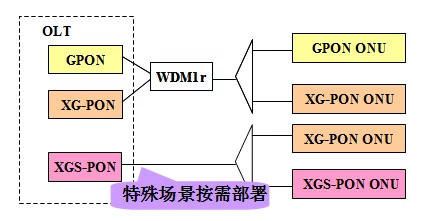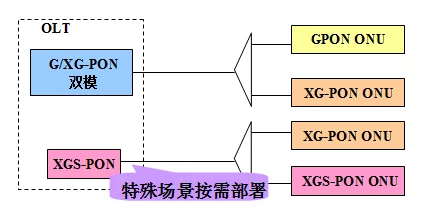Under the active promotion of “broadband China” and “speed up and down payment”, the broadband network is playing an increasingly prominent role as the basic platform for economic and social development. The Internet video application is rapidly gaining popularity, and the high-bandwidth business of 4K/8K HD, family cloud and video is also growing. In order to cope with the fierce market competition, operators have generally provided hundreds of megabytes (such as 100M, 200M, 500M), and opened gigabit business in some developed regions as direction.
At present, 1G-EPON and GPON have been widely deployed in China. Policies to promote, competitive drive, demand, prompting broadband access network began to MB, gigabit, to meet user demand, access technology need to be based on the rate of 10G PON technology of a new generation of platform upgrade, 10G rate of PON technology mainly includes 10G EPON, XG PON, XGS – PON.
The 10G-EPON standard is IEEE802.3av (later incorporated into IEEE802.3), including 10G/10G symmetric and 10G/1G asymmetric two modes. At present, 10g-epon technology and equipment have been very mature, and China Telecom successfully realized the chip level and system level of 10g-epon in 2011. The 10g-epon device has been deployed in the FTTB scenario scale and started deployment of FTTH scenarios. Due to the difference in the cost difference between symmetric and asymmetric PON, in order to reduce the type of plate card, the OLT side only deployed symmetrical 10g-epon port in principle. Since the 10g-epon port of OLT can be compatible with three types of ONU, including 10G/10G symmetric, 10G/1G asymmetric 10g-epon ONU and 1G/1G EPON ONU, the ONU can be flexibly deployed according to user requirements.
Recently, China Telecom has focused on narrowing the range of 10G/1G EPON uplink. According to the IEEE802.3 standard, the uplink wavelength range of 10G/1G EPON is 1260nm ~ 1360nm. The purpose of this regulation is to be consistent with the uplink wavelength range of 1g-epon, but the biggest problem is to take up the precious resources of the O band 100nm. China Telecom has proposed narrowing the range to 1260nm ~ 1280nm (as shown in figure 1), which is consistent with the uplink wavelength range of 10G/10G EPON. In 10G / 1G EPON ONU has not scale FTTH deployment of uplink wavelength, the wavelength of O band can be more resources for the future of PON technology, is of great significance to maintain the sustainable development of PON network.

Figure 1. The range of ascending wavelengths is narrowed
The XG-PON standard is the ITU-T G. 987 series, which is the asymmetric mode of the descending 10Gbit/s and the upward 2.5Gbit/s. At present,XG-PON technology and equipment have been mature. In particular, China Telecom has successfully implemented XG-PON laboratory communication in 2016 after nearly two years of testing, and has been verified in field trials. Recently, XG-PON will be deployed in FTTH scenarios.
The deployment of XG-PON should focus on the coexistence of GPON and XG-PON. Due to the difference between GPON and XG-PON and the range of uplink wavelengths, both of them coexist in a different way. There are two main types of coexistence schemes: the first is to use WDM1r (as shown in figure 2), which is described in the ITU-T standard; The second is to co-exist with GPON/XG-PON dual mode PON (optical module), which is an innovative scheme proposed by China Telecom (shown in figure 3). The proposal of China Telecom’s innovative solution is mainly to solve the problem of the insertion loss of about 1.5db in WDMr1, which leads to the problem of tight budget or shortage of link budget, and it is also easier to implement the project. Overall, these two kinds of schemes on whether ODN introduction of insertion loss, upgrade the construction difficulty, difficulty of equipment development, whether can use existing resources have different features (see the coexistence of two kinds of scheme comparison shown in table 1), there will be application scenario. At present, the two co-existing methods, especially the GPON/XG-PON dual-mode PON, have been verified by laboratory and field tests.

Figure 2. GPON co-exists with XG-PON using WDM1r

Figure 3. GPON coexists with XG-PON through dual mode PON (Optical module)
Table 1. comparison of GPON and XG-PON coexistence mode
| Method a (WDM1r way) | Method b (Dual-mode PON port way) | |
| The introduction of insertion loss | WDM1r introduced about 1.5dB insertion loss | Independent WDM1r is not required, no insertion loss is introduced for ODN |
| Construction | The engineering construction is more complex, it needs to disconnect the main fiber and insert WDM1r | The engineering construction is simple, and the GPON plate can be replaced by a double-mode PON |
| Development difficulty | Development is relatively simple | Dual-mode optical modules are difficult to develop |
| Resource utilization | The original GPON board can be reused | The original GPON can not be used (can be moved to other OLT); In the future, with XG-PON, the GPON part of the dual-mode optical module is wasted |
The two-mode PON usually implements two link budget levels, one is GPON Class B+ and XG-PON Class N1 integration, and the other is GPON Class C+ and XG-PON Class N2a integration. Due to GPON and XG-PON standards, the budget value of link is slightly different (GPON Class B+ is 28dB,XG-PON Class N1 is 29dB; GPON Class C+ is 32dB,XG-PON Class N2a is 31dB, and the integration of the two needs to form a unified link budget value. Considering that the two-mode PON needs to be compatible with the deployed GPON ONU, it should be unified according to the GPON link budget value (see figure 4). China Telecom has proposed the two link budget levels for the two-mode PON Class D1 (28dB) and Class D2 (32dB), and has made a slight adjustment on the basis of ITU-T standard, forming the specific indexes of optical interface parameters. In addition, it needs to be explained that the index of the two-mode PON is only related to OLT side, and the index of ONU optical interface has not changed.

Figure 4. dual-mode PON port link budget level diagram
XGS-PON is the PON technology of the recent standard 10Gbit/s symmetric rate of ITU-T, and its standard g. 9807.1 was released in June 2016. There are two main modes of deployment of XGS-PON. The first (shown in figure 5) is the direct deployment of XGS-PON on the OLT side, which can be subdivided into GPON and XGS-PON to coexist in WDM1r mode and support coexistence of GPON/XG-PON/XGS-PON. Since OLT XGS-PON can be compatible with XG-PON and XGS-PON ONU (when Basic wavelength set is adopted, OLT supports 10G and 2.5G double rate receiving), no additional XG-PON is required on the OLT side. The second (as shown in FIG. 6) is dominated by XG-PON on the OLT side to meet the main needs of residential users; XGS-PON is designed for special scenarios with high uplink bandwidth requirements (e.g., enterprise users), deployed on demand, without considering co-existence with GPON.
Considering the different network situation and different deployment time, different operators may adopt different strategies to deploy XGS-PON. Due to the short release time of the ITU-T standard of XGS-PON, equipment maturity and interoperability have not been fully verified; At the same time, the recent XGS – PON OLT side mouth and XG – PON port cost gap is still not negligible, and from the Angle of demand, mainly residential users asymmetric bandwidth demand, therefore, the recent XGS – PON deployment to mode 2. Appropriate.

(a) GPON co-exists with XGS-PONin WDM1r mode

(b) The GPON/XG-PON/XGS-PON model PON support co-existed
Figure 5. XGS-PON deployment model I

GPON and XG-PON coexist in WDM1r mode

GPON and XG-PON co-exist with GPON/XG-PON dual mode PON
Figure 6. XGS-PON deployment model II
For the future evolution of PON technology, ITU – T established NG – PON2 (g. 989 series), IEEE 802.3 ca task group is working on 100 G – EPON (25 G, 50 G, 100 G three rate), but “PON fusion” is the direction of the deserves more attention. For a long time, the ITU – T and IEEE standards for PON respectively, two big system in their respective evolution, but meet the demand of basic same, this caused great waste in equipment development, also increased the complexity of the network deployment. PON fusion for operators, equipment manufacturers, chip and device manufacturers and other industry chain of each link to bring tangible benefits, since November 2016 in Broadband Forum began to discuss, as the principles and direction, in the industry get more and more common. However, it is a long and complicated process to realize PON fusion. At present, the basic consensus is that it is difficult to change the research scope and operation mechanism of each standard organization. PON integration should be realized mainly through the bottom-up efforts of the members of the standard organization.
In order to promote PON integration, the next step is to carry out the work in both non-technical and technical aspects. Non-technical factors are more important, because there are not completely technical factors in the current two PON standard systems. Need to explore effective coordination between different standards organization of the specific mechanism, adopt various forms to gradually build consensus, elimination of PON fusion related concerns, push related standards organization in the new standards are conducive to the PON. In terms of technology, it is necessary to gradually converge the deployment time point, speed, link budget and coexistence of the next generation of PON between ITU-T and IEEE; At the same time, key problems such as single wavelength and multi-wavelength, speed of each wavelength, fixed or adjustable wavelength are analyzed, and the most suitable technical direction of the fusion PON is selected.
As China has become the largest PON market in the world, Chinese operators and manufacturers should play a bigger role in promoting PON integration. Held in the middle of July, 2017 IEEE 802.3 ca meeting, a joint proposal based on the Chinese operators, vendor and push, in 25 G, 50 G and 100 G EPON PON fusion has been widely supported, the time schedule of the standard of PON fusion target oriented has been adjusted, 50 G and 100 G EPON began to demonstrate the implementation of the way, PON fusion and a solid step forward.